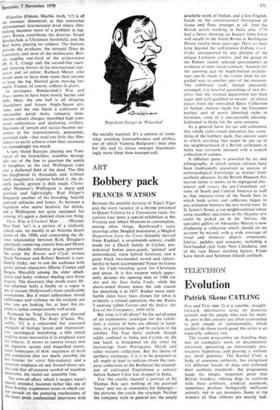TELEVISION
Evolution
Patrick Skene CATLING
Pets and Vets (Bac 2) is a sensible, straight- forward, informative series on domestic animals and the people who care for them. As pets in this country are often enshrouded in pink clouds of sentimentality, which couldn't do them much good, the series is an especially salutary one.
The recent programme on breeding dogs was an exemplary work of documentary television, presenting an interestingly pro- vocative hypothesis and proving it without any shrill polemics. The Kennel Club, a body of awesome authority, has recognised Ill different breeds of dogs and ordained their aesthetic standards: the programme made the simple, important point that British breeders, refining dogs to conform with these arbitrary, artificial standards, sometimes produce biologically inefficient animals, not to say monsters. Some of the winners of blue ribbons are merely ludi-
crous; others should make their owners feel ashamed.
Commentator Jack Pizzey exhibited a specimen pug ea very popular dog') as an example of canine fashions that cause dogs physical distress. The flatness of the profile, a feature carefully accentuated by selective breeding to gratify some perverted human whim, makes it difficult for the wretched creature to breathe (convincing close-up of wretched creature experiencing difficulty in breathing). The Pekinese suffers in much the same way, because of its unnaturally tiny (pretty?) nostrils. A vet said he would like to see a Peke with a long nose, and it was clear that he meant what he said; he didn't say it just to cause innumerable laps to tremble with indignation.
There were words of implicit rebuke also for fanciers of the chow, the toy poodle, and even the bulldog breed itself. The chow is bred for straight back legs, which are weaker than they should be, and compel the most aristocratic chows to bring up their rears with a mincing clockwork gait. The toy poodle has 'knee-cap difficulties'. And the bulldog, a lithe, athletic baiter of bulls only 150 years ago, has been reduced to a bow-legged slob. We were shown a bulldog of the 1970s, a pathetically snuffling, red. eyed degenerate that fell flat on its face in competition in the show ring. The political analogies were too painful to contemplate —like seeing Union Jack chamber pots in Carnaby Street.
On the other hand, mankind's interven- tion in animals' evolutionary progress can be helpfully constructive, as demonstrated by Look. Stranger: The Men Who Invented a Cow (BBC Scotland on BBC 2), which told of three Scottish farmers, the Cadzow brothers, who have 'turned Darwinian theory into an industry'. In the past twenty- five years, on the isle of Luing, off the coast of Argyllshire, they have bred the first successful new breed of beef cattle for nearly 200 years. It was said that the new breed is robust, quick-growing, lean, and good to eat. The beasts may not derive much plea- sure from their edibility, of course, but they lead a healthy life while it lasts, and they can look forward to the prospect of royal patronage -at Balmoral or, such is their reliable uniformity, to popular patronage in the supermarkets.























































 Previous page
Previous page